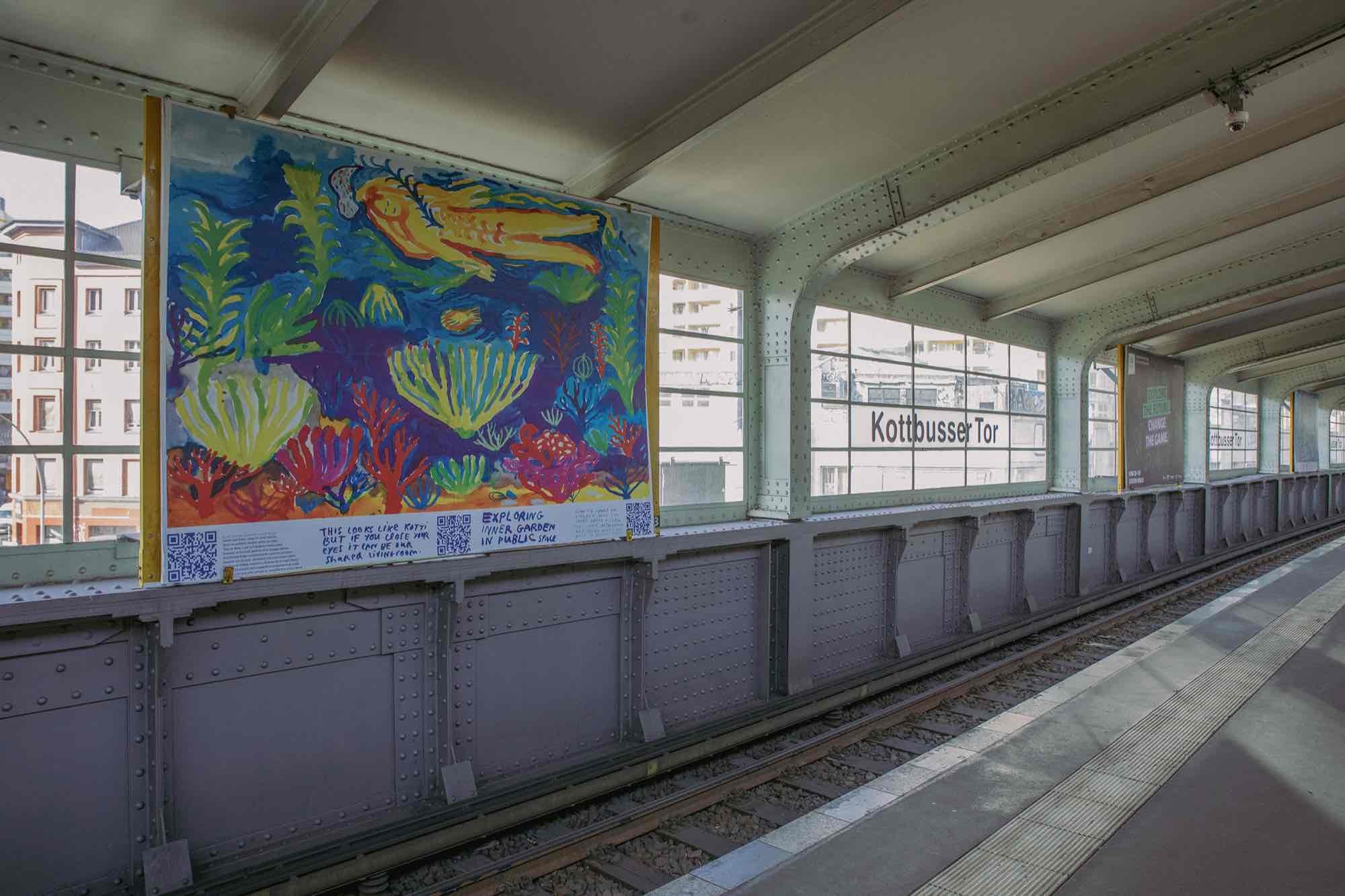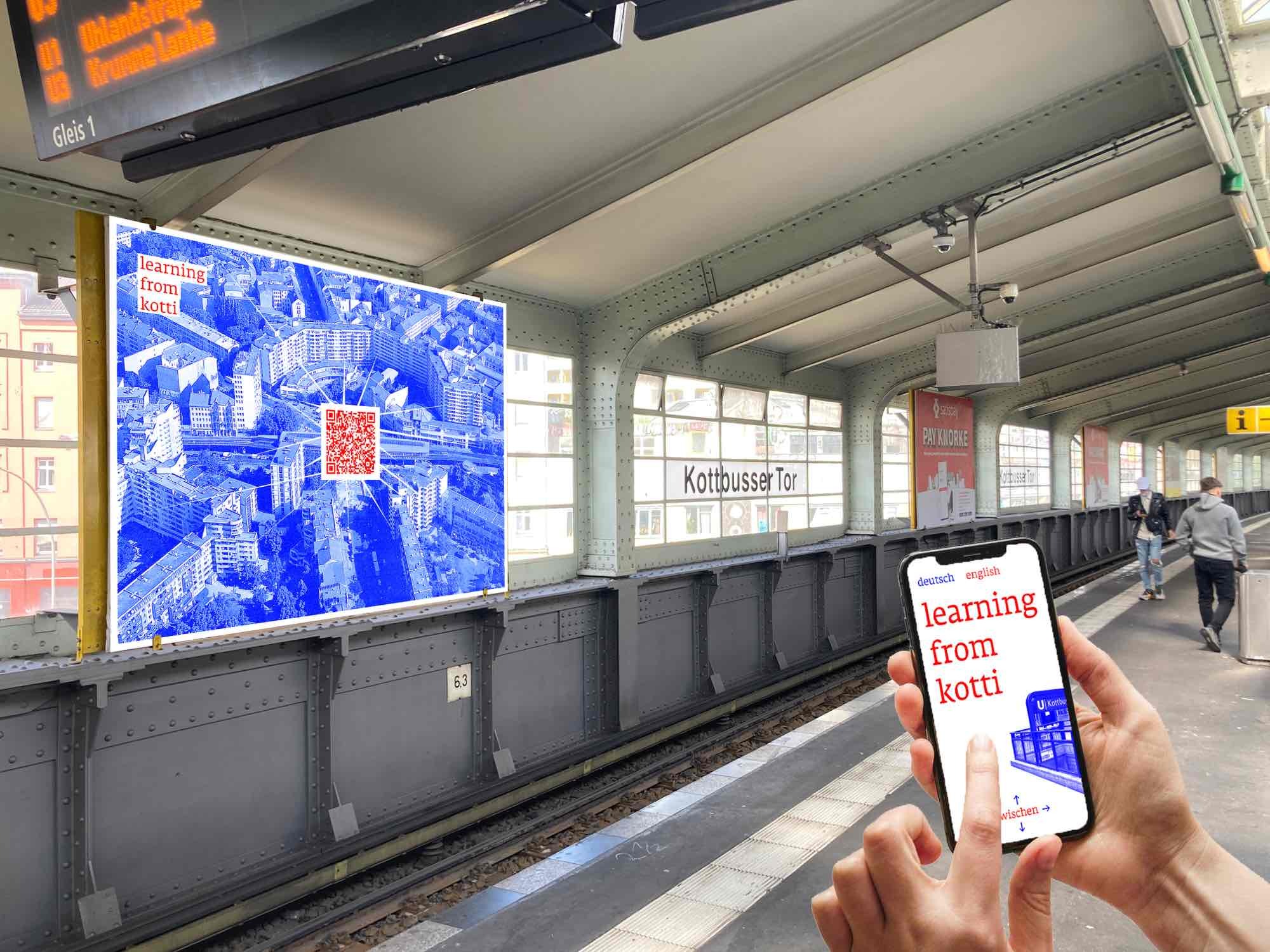New Urban Publics
08 Jun - 10 Aug 2023

Irene Fernández Arcas, Exploring Inner Care in Public Spaces, Art in the Underground 22/23: New urban publics, installation view, Kottbusser Tor, Berlin, 2023. Photo: Silke Briel/nGbK

Irene Fernández Arcas, Exploring Inner Care in Public Spaces, Art in the Underground 22/23: New urban publics, installation view, Kottbusser Tor, Berlin, 2023. Photo: Silke Briel/nGbK

Irene Fernández Arcas, Exploring Inner Care in Public Spaces, Art in the Underground 22/23: New urban publics, installation view, Kottbusser Tor, Berlin, 2023. Photo: Silke Briel/nGbK

Irene Fernández Arcas, Exploring Inner Care in Public Spaces, Art in the Underground 22/23: New urban publics, installation view, Kottbusser Tor, Berlin, 2023. Photo: Silke Briel/nGbK

Liminal Beast of Prey: Core of Genesis., Performance, Art in the Underground 22/23: New Urban Public, square in front of the red town hall, Berlin, 2023. Photo: Silke Briel/nGbK

Liminal Beast of Prey: Core of Genesis., Performance, Art in the Underground 22/23: New Urban Public, square in front of the red town hall, Berlin, 2023. Photo: Silke Briel/nGbK

Liminal Beast of Prey: Core of Genesis., Performance, Art in the Underground 22/23: New Urban Public, square in front of the red town hall, Berlin, 2023. Photo: Silke Briel/nGbK

Sunny Pfalzer, Performance as part of Scores for Fake Authenticity, Art in the Underground 22/23: New urban public spaces, Strausberger Platz, Berlin, 2023. Photo: Silke Briel/nGbK

Sunny Pfalzer, Performance as part of Scores for Fake Authenticity, Art in the Underground 22/23: New urban public spaces, Strausberger Platz, Berlin, 2023. Photo: Silke Briel/nGbK
Art in the Underground 2022/23: New Urban Publics
Artists: Irene Fernández Arcas, Sunny Pfalzer, Julieta Ortiz de Latierro, image-shift, Liminal Beast of Prey, Chargé (Sinzo Aanza, Jasmina Al-Qaisi, Falonne Mambu, Nada Tshibwabwa, Ralf Wendt and Elsa Westreicher).
Based on the idea of the square as a place of public interest, as a meeting point, and discursive arena, three Berlin squares and their underground stations serve as a starting point for performances and interventions. The Kottbusser Tor, the Strausberger Platz and the square in front of the Rotes Rathaus are architecturally striking and extremely different, partly cut by streets or spanned by bridges and elevated railways, partly classically symmetrical with a fountain as the central element. This urban and public space is used in various ways and for different means: traffic, consumption, play, communication, or recreation. The selected artistic works question or reinforce these uses.
Irene Fernandez Arcas is interested in the healing potential of art; focusing on the neoliberal exploitation of self-care, body, and mind, her work examines the desire to achieve intimacy and make connections in urban settings. A digital project by the collective image-shift from Sandy Kaltenborn, Athena Javanmardi, and Paco Camberlin counters the oversimplified media image of Kottbusser Tor as a problem zone with a view of its many-layered social fabric. Julieta Ortiz de Latierro’s three-part project consists of a photographic intervention at Kottbusser Tor underground station, a one-day workshop in a nearby park, and a video produced as part of Art in the Underground and shown on in-train info screens throughout Berlin’s public transport network. In Sunny Pfalzer’s durational performance at Strausberger Platz, three performers explore the tensions between gender diversity and the binary gaze with which queer bodies are confronted in public space. For the project Chargé, six artists (Sinzo Aanza, Jasmina Al-Qaisi, Falonne Mambu, Nada Tshibwabwa, Ralf Wendt, and Elsa Westreicher) from Germany and the Democratic Republic of Congo, come to Strausberger Platz with performances, literature, sound works, and graphics that criticize exploitation and consumerism. Core of Genesis is an artistic wrestling performance that addresses current global political concerns. With the help of humor, storytelling, choreography, and combat tricks, the collective Liminal Beast of Prey creates an unconventional show chock-full of energy that provides space for often-invisible narratives, celebrates queer identities and expresses post-capitalist desires.
Originally called “Art Instead of Advertising,” the competition was first held in East Berlin in 1958, with entrants asked to submit posters for peace. The works were shown on platform billboards at Alexanderplatz underground station. Whereas many East German institutions were dissolved or renamed after 1989, this competition survived in its original form. Since the early 1990s, neue Gesellschaft für bildende Kunst (nGbK) has been realizing projects in cooperation with Berlin’s Senate Office for Culture under the title “Art in the Underground” with artworks in or near underground stations.
nGbK work group: Lorena Juan, Marenka Krasomil, Isabelle Meiffert, Sandra Teitge, Mirko Winkel
Artists: Irene Fernández Arcas, Sunny Pfalzer, Julieta Ortiz de Latierro, image-shift, Liminal Beast of Prey, Chargé (Sinzo Aanza, Jasmina Al-Qaisi, Falonne Mambu, Nada Tshibwabwa, Ralf Wendt and Elsa Westreicher).
Based on the idea of the square as a place of public interest, as a meeting point, and discursive arena, three Berlin squares and their underground stations serve as a starting point for performances and interventions. The Kottbusser Tor, the Strausberger Platz and the square in front of the Rotes Rathaus are architecturally striking and extremely different, partly cut by streets or spanned by bridges and elevated railways, partly classically symmetrical with a fountain as the central element. This urban and public space is used in various ways and for different means: traffic, consumption, play, communication, or recreation. The selected artistic works question or reinforce these uses.
Irene Fernandez Arcas is interested in the healing potential of art; focusing on the neoliberal exploitation of self-care, body, and mind, her work examines the desire to achieve intimacy and make connections in urban settings. A digital project by the collective image-shift from Sandy Kaltenborn, Athena Javanmardi, and Paco Camberlin counters the oversimplified media image of Kottbusser Tor as a problem zone with a view of its many-layered social fabric. Julieta Ortiz de Latierro’s three-part project consists of a photographic intervention at Kottbusser Tor underground station, a one-day workshop in a nearby park, and a video produced as part of Art in the Underground and shown on in-train info screens throughout Berlin’s public transport network. In Sunny Pfalzer’s durational performance at Strausberger Platz, three performers explore the tensions between gender diversity and the binary gaze with which queer bodies are confronted in public space. For the project Chargé, six artists (Sinzo Aanza, Jasmina Al-Qaisi, Falonne Mambu, Nada Tshibwabwa, Ralf Wendt, and Elsa Westreicher) from Germany and the Democratic Republic of Congo, come to Strausberger Platz with performances, literature, sound works, and graphics that criticize exploitation and consumerism. Core of Genesis is an artistic wrestling performance that addresses current global political concerns. With the help of humor, storytelling, choreography, and combat tricks, the collective Liminal Beast of Prey creates an unconventional show chock-full of energy that provides space for often-invisible narratives, celebrates queer identities and expresses post-capitalist desires.
Originally called “Art Instead of Advertising,” the competition was first held in East Berlin in 1958, with entrants asked to submit posters for peace. The works were shown on platform billboards at Alexanderplatz underground station. Whereas many East German institutions were dissolved or renamed after 1989, this competition survived in its original form. Since the early 1990s, neue Gesellschaft für bildende Kunst (nGbK) has been realizing projects in cooperation with Berlin’s Senate Office for Culture under the title “Art in the Underground” with artworks in or near underground stations.
nGbK work group: Lorena Juan, Marenka Krasomil, Isabelle Meiffert, Sandra Teitge, Mirko Winkel

